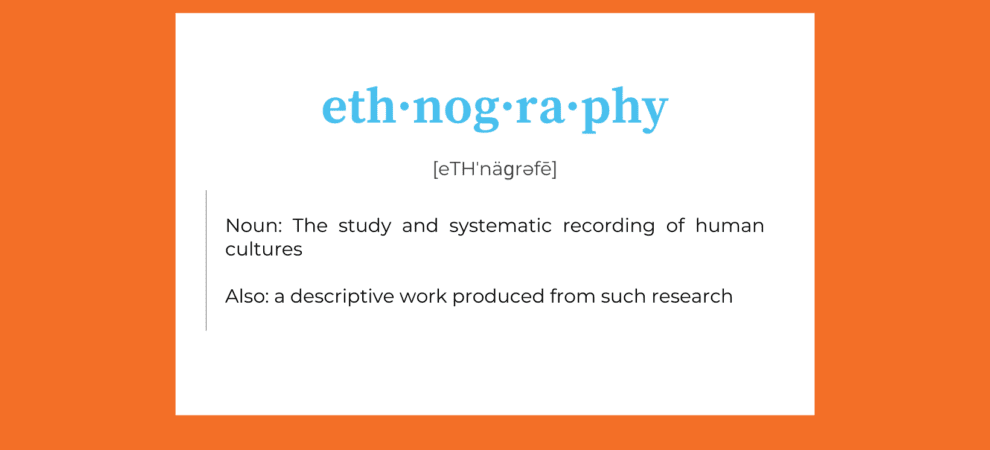
This piece is part of a series that builds on previous discussions, exploring how storytellers and communicators can approach inclusivity in their work. In our previous installments, we delved into participatory grantmaking and Design Thinking, both of which provide valuable models for communicators. Now, in this final piece, we explore how the principles of ethnographic listening can further enhance our ability to embrace inclusivity in our work as communicators.
Empathetic listening goes beyond the mechanical process of processing words; it involves understanding and respecting different ways of communication, including non-verbal signals someone might use such as emotions, contexts, and underlying messages. This form of listening is deeply rooted in ethnographic research, a method anthropologists use to study cultures and communities. Ethnography emphasizes immersion and observation, allowing researchers to gather insights from within the community rather than imposing external interpretations.
This overarching principle reinforces why Minerva Strategies begins each client engagement with a Discovery phase. During this time, we immerse ourselves in our client’s world. We learn as much as possible about their work, plans, and key audiences. This deep dive involves interviewing diverse stakeholders, including staff, board of directors, and supporters (just to name a few). These conversations, combined with our material review process, illustrate the principles of ethnography in practice. By listening attentively and observing, we can better understand the nuances within our client’s environments, which sharpens our ability to deliver tailored and effective communications support.
Communicators can adopt several ethnographic principles, especially those who seek to foster greater inclusivity in their efforts:
1. Immerse Yourself in the Community
Just as ethnographers live within the communities they study; communicators should spend time in the environments of the people they wish to represent. This immersion helps to understand daily challenges, cultural nuances, and the community’s unique worldview. This immersion may not be a literal change of location. Instead, it can happen through a period of deep learning of the subject’s environment or circumstances that surround their work. At Minerva, this looks like exploring our client’s world through our Discovery process, which typically includes a desk review of materials, landscape analysis, and studying the client’s sector through articles, podcasts, books and other content types.
2. Observe Without Judgment
Ethnography teaches us to observe and ask questions without preconceived notions. This unbiased observation is crucial for communicators who wish to capture authentic stories in their work. Our ability to ask meaningful questions and listen for understanding is critical throughout a client engagement. Once we have begun to study a client’s environment, Minerva’s concurrent step is to craft compelling questions that will lead to greater insights and uncover knowledge gaps. A standard approach is asking the “Five Whys,” which challenges us to reveal root causes, rather than stopping at the earliest responses. Asking thoughtful questions and receiving truthful answers also requires us to suspend judgement. By doing this, we understand the true experiences and feelings of others. This also helps root out biases impacting our interpretation of what was shared and tell stories that are true to the individual.
3. Engage in Deep Listening
In conversation, it is often easy to listen to respond. Deep listening involves tuning into non-verbal cues, emotions, and subtle contexts. It’s about understanding what is said, unsaid, and why. Bringing this level of attentiveness ensures that the stories we tell are rich, nuanced, and reflective of the people’s experiences. Doing this in a virtual environment is challenging but possible. Encouraging cameras to be turned on during conversations will allow you to see more non-verbal cues than a limited phone conversation. Likewise, paying attention to voice inflections — or sudden pauses—will provide subtle hints to important moments in conversation.
4. Build Trust
Trust is foundational in ethnography and empathetic listening. As discussed in our blog on participatory grantmaking, building trust requires time, consistency, and genuine interest in the community’s well-being. Our client engagements are most fruitful when we have a steady cadence of meetings scheduled and attended. This is especially true during the early stages of our partnerships, when norms are still being established. By implementing weekly or biweekly check-ins, we are able to pay close attention to the circumstances that are impacting a client’s workload and adjust our efforts accordingly.
Empathetic listening is an essential skill for communicators aiming to foster inclusivity. By integrating ethnographic principles into our efforts, we can create narratives genuinely reflective of diverse voices and experiences. These methods help dismantle traditional power dynamics in storytelling, ensuring that those who have been historically marginalized are not only heard but are active participants in shaping their narratives. It also allows for deeper client engagements as we embrace their world to mitigate potential challenges or amplify opportunities. In implementing these approaches, we enhance the inclusivity of our work, become better partners to our clients, and enrich the fabric of the stories we tell.